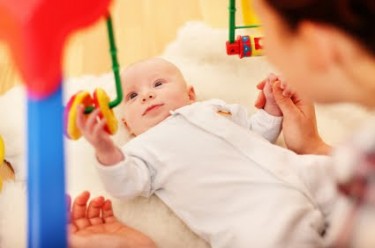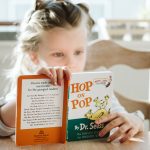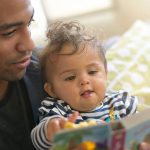“Ugh… he puts everything in his mouth!” This common refrain from parents of babies always strikes me as a wonderful time to begin educating parents about how babies learn. Babies and toddlers learn about the world through sensorimotor experiences.
 They learn about “soft” by feeling a cozy blanket, about music as a comfort by hearing a parent sing, and about smell by crawling close to the cabinet holding the baking supplies. They can learn volumes about that less-than-clean sock, by sticking it lovingly into their mouths. Yes, the same mouth you have tried endlessly to give only sterilized nipples, organic food, and clean toys.
They learn about “soft” by feeling a cozy blanket, about music as a comfort by hearing a parent sing, and about smell by crawling close to the cabinet holding the baking supplies. They can learn volumes about that less-than-clean sock, by sticking it lovingly into their mouths. Yes, the same mouth you have tried endlessly to give only sterilized nipples, organic food, and clean toys.
Babies and toddler create concepts by considering what they have learned through their senses. If a child learns that those black things will four legs are called “puppy,’ then until they have more sensory information, everything black with four legs, including the cat next door, will be called “puppy.” In time, the child may hear a cat meow or a dog bark, and use that information to split the animals in to two categories.
For babies, crying is a means of communicating and teaches them that they can have an effect on their environment. They can make someone respond. Similarly by smiling, they can make someone else smile. That’s an incredible discovery. Sensory development supports later cognitive, physical, and emotional growth.
Now the question is how can you, the parent, use this information to support your little learner? Consider these 3 tips:
- Acknowledge yourself as your child’s first and best teacher. Babies spend a great deal of their time eating, cuddling, and playing with the grown-ups in their lives. This is an important time of learning for both you and them. As you go through these daily activities pay attention to how your child responds. Are they pleasing and fun or should you try something else? Is the music too loud? Your movement too fast or too slow? You have the wonderful opportunity as parents to acknowledge your child’s interests and preferences and use them to maximize their sensory learning experiences.
- Create a multi-sensory environment. Consider the 5 senses; touch, sound, smell, taste, sight. Get down on your child’s level to better understand what the environment looks like from their point of view. Take a look at the objects in their visual field. Young babies like simple, high-contrast pictures. Offer them different surfaces to play on; soft blankets, bumpy mats, water, etc. You can add a small amount of essential oil to the lotion you use on your baby or having them in the kitchen while you are cooking. Play different types of music while they are lounging in a bouncy seat or playing.
- Use every day experiences to enhance your child’s learning. Rather than simply reading a book, concentrate on your intonation, read books that can be sung, and vary voices for different characters. During mealtime, try offering children cold and warm, harder and softer foods. Talk about the differences they are experiencing. Dance with your child swaying slowing and moving more quickly. Have them close by as you sort and fold warm laundry. They’ll experience smell and touch, the sight of you folding, and the sound of your voice explaining what you are doing. The possibilities are endless.



